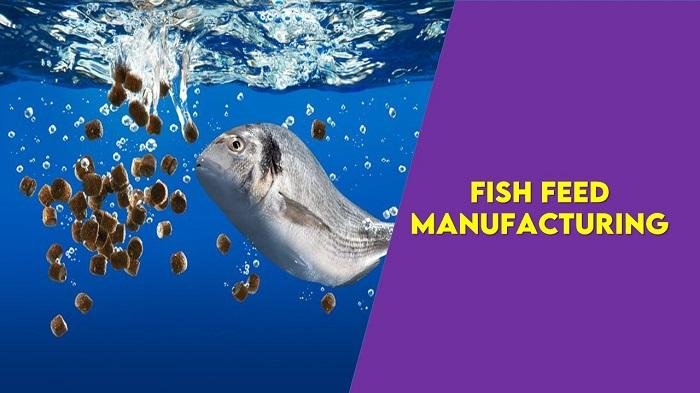Fish feed manufacturing and it’s important in aquaculture

Fish is a vital source of both nutrition and income generation for numerous local people’s livelihood in the whole world. Feed is one of the main inputs in the fish farming system. Feed formulation procedures involve nutritionally complete and economically sustainable feed. Feed accounts for almost 50% of the variable cost of fish production.
In animal production systems, good nutrition is important to the economic production of a healthy, high-quality output. Nutrition is crucial in fish farming (aquaculture) since feed accounts for almost half of the variable production cost. In recent years, fish nutrition has evolved substantially with the implementation of novel, comprehensive commercialized feeds which enhance effective fish health and performance. The creation of novel species-specific feed formulas helps the aquaculture business grow to meet the growing demand for inexpensive, safe, high-quality fish and seafood products.
Conventional feed source
These are the feedstuffs that are commonly used in the preparation of fish feed. Their application is standardized and widely accepted. Many of these are inexpensive and widely available in huge numbers. They are mostly agricultural or industrial items. Wheat bran, groundnut cake, and rice bran are a few examples. Some are derived from animals (fish meal, blood meal, and shrimp meal), while others are derived from plants (maize, soya bean meal, cottonseed meal).
Feed formulation
Feed formulation procedures involve the combining and blending of feed materials (based on a formula) into a nutritionally complete and economically sustainable feed that can be utilized in the appropriate amount to give the desired level of production in fish cultivation.
Feed manufacturing process
The processing procedures, which include sourcing, mixing, pelleting, drying, and storing, are critical because they govern nutritional bioavailability, attractiveness, palatability, as well as longevity, all of which have a significant impact on fish performance. The types of fish feed, such as floating fish feed as well as sinking fish feed, are determined by the species of fish farming.
Source of raw ingredient
It involves the investment of high-quality ingredients at very cheap prices since the quality of the ingredients consistently determines the quality of the prosperity and cost of the ingredients.
Grinding of feed ingredients
Typically, a hammer mill is used for grinding fish feed ingredients. The coarseness or fineness of the constituent structure has a considerable impact on both the physical characteristics and nutritive value of the completed product. Grinding aids in the proper mixing of various materials enhances pellet quality, minimizes pellet breakage, and boosts fish feed acceptability and ingestion.
Weighing and mixing
Weighing must be precise to guarantee that the feed ingredients are in the right quantities as specified in the diet. To guarantee correct blending, the feed ingredients are physically blended after weighing. This is the most crucial and challenging stage of fish feed manufacturing since the feed manufacturer must ensure that the ingredients are combined properly.
Conditioning
Addition some amount of the water for moisturizing all ingredients before pelleting. It is beneficial for feed pelletizer to make high stability feed.
Pelleting of feed
This is accomplished through the use of a locally manufactured pelleting machine, which can be operated manually or electrically. It is made up of cylindrical dies of variable diameters that are used to pellet varying sizes of feed according to the age, size, and species of fish involved. The majority of fish feed manufactured is in the form of compressed pellets. The pelletized feed has many advantages, including less feed waste, more uniform feed intake, and the removal of growth inhibitors.
Drying of feed
Drying is done instantly after pelleting, to reduce moisture existing in the feed. Drying improves the stability of the feed for adequate storage.
Sprayer
Oil sprayer to the spray required amount of oil over the fish feed as well as proper oil mix with feed. After the oil mixture is in the feed further, go for cooling.
Cooler
Cooler required for just cooling of the feed and sieving before labeling and packaging. Sieving is also required to remove extra fine particles attached to the feed. It is helpful for feed quality and marked accessibility.
Labeling and packaging
Packaging is just required for selling feed with a specific weight of feed in one bag. After packaging the sealing of the bag. Labeling of the packet such as quantity, net weight, batch no., date of manufacture, self-life as well as storage environment of feed. The proximate composition is also shown in the bag such as crude protein, crude lipid, fiber, moisture, and ash.
Feed care and storage
Mold development and feed degradation are accelerated by high moisture levels. Avoid improper handling as well as breakage to the feed bags, which could shatter the pellets and produce fines (powder) that the fish will not ingest. Mice, rats, roaches, and other pests should be properly controlled in the feed storage facility since they consume and contaminate feed while also transmitting diseases.
Conclusion
Nutrition is crucial in fish farming (aquaculture) since feed accounts for almost half of the variable cost of production. Feed formulation is used in the appropriate amount to achieve the desired level of production in fish farming. Vitamins, proteins, and lipids are particularly heat-sensitive, and high storage temperatures can easily denature them.
Note- this article is taken from Times of Agriculture magazine, authored by Jham Lal
Join Times of Agriculture
Get the latest Agriculture Magazine and regular important updates right on your phone.
👉 Join WhatsApp Group